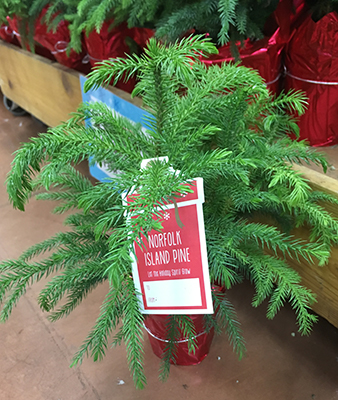Norfolk Island Pine

Norfolk Island pine (Araucaria heterophylla) is a popular houseplant gift during the holidays. Often given to be used as a small Christmas tree, these wonderful little trees can brighten your home long after the holidays end.
While this tree can grow quite large in its natural habitat, Norfolk Island pine is slow growing. After about a decade, it may eventually reach 5 to 8 feet tall as a houseplant, but this potted tree will not surprise you with explosive growth.
As with so many holiday gift plants, some Florida gardeners may be able to plant their Norfolk Island pine in their landscape after they are done enjoying its beauty indoors. It should be noted though, that this naturally coastal tree does not hold up well during hurricanes.
Characteristics
Norfolk Island pines are not true pines; they are members of a pre-historic family of conifers Araucariaceae, an incredibly diverse and widespread plant family during the Jurassic and Cretaceous time periods. The end of the Cretaceous period saw not only the extinction of the dinosaurs, but the extinction of members of the Araucariaceae family in the northern hemisphere. However, in the southern hemisphere, members of the Araucariaceae family continued to thrive. Today there are three genera—Agathis, Arucaria, and Wollemia—with a combined total of 41 species.
Norfolk Island, where this tree hails from, is located in the South Pacific between Australia, New Zealand, and New Caledonia. The flag of this Australian territory actually features the Norfolk Island pine. While sold here in the states as tabletop Christmas trees, in their native habitat these plants can incredibly reach 200 feet tall and have trunks that swell to 10 feet in diameter! In Florida these trees typically grow to only 60 to 80 feet.
While not true pines, their tiered branches, slender pyramidal or columnar shape, and narrow evergreen leaves appear pine-like. Norfolk Island pines have a single upright trunk and occasionally develop a graceful lean. These trees are tropical plants that thrive on humidity and can’t tolerate temperatures below 35°, so Orlando is the approximate northern range of this plant. Naturally found in coastal areas, it is no surprise that these plants have a high salt tolerance.
Planting and Care

Indoors, these plants need quite bright light and humidity. If your find that your plant is not thriving, in all likelihood it is likely not receiving sufficient light or humidity.
In Florida we know all about humidity, but we strive to keep it out of our homes, so how do you make it humid for your houseplants? Overwatering is not the answer; Norfolk Island pines don’t appreciate being too wet. Instead, fill a saucer with water and rocks or gravel, then place the potted plant on top making sure the pot is not sitting directly in water. There you have it—you’ve created your own little high-humidity microclimate. When you find the spot in your house with the right light for your plant, don’t forget to turn the plant every week or so to keep it growing straight and upright.
If you are planning to give your Norfolk Island pine a spot in your landscape, remember that these trees get quite large. Be sure you have the room for a 60 to 80 foot mature tree. If not, consider simply enjoying this lovely little tropical tree in your home.
